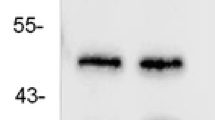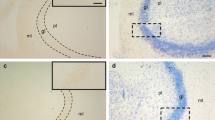Abstract
Neuropeptides are stored together with the classical neurotransmitter in large dense core vesicles from where they are released upon stimulation. In animal models, neuropeptides have been shown to influence neuronal excitability. For example, an anticonvulsive action was found for neuropeptide Y (NPY), galanin, dynorphin and somatostatin. By contrast, substance P was found to have a proconvulsive action. We investigated the expression of NPY, dynorphin, secretoneurin and chromogranin B in hippocampi from patients with intractable temporal lobe epilepsy (TLE) (n=29; mean age=34.5 years; mean duration of epilepsy=21.4 years) and post mortem controls (n=21; mean age=57.7 years; mean post mortem delay=17.2 hours). In situ hybridization for dynorphin showed a marked increase of mRNA expression in granule cells of the dentate gyrus. For NPY, we found increased mRNA expression in hilar interneurons. Immunohistochemical staining showed a sprouting of neuropeptide-containing axons. Antibodies for dynorphin, secretoneurin and chromogranin B labeled mossy fiber terminals in the inner molecular layer of the denate gyrus of patients with, but not without, hippocampal sclerosis. NPY- and secretoneurin-containing interneurons revealed a dense plexus of fibers in the molecular layer and the hilus of the dentate gyrus as well as in stratum lucidum, the terminal field of mossy fibers. Radioligand binding to the NPY Y2 receptor, which mediates anticonvulsive actions of NPY, was increased in the hippocampus of TLE patients. In summary, our data show a marked reorganization of hippocampal circuits and an upregulation of the expression of dynorphin, NPY and the Y2 receptor in the epileptic hippocampus. These changes may contribute to endogenous anticonvulsive mechanisms in TLE patients.
Zusammenfassung
Neuropeptide werden gemeinsam mit klassischen Neurotransmittern in Vesikeln gespeichert und freigesetzt. In Tiermodellen konnte eine Veränderung der Anfallsschwelle durch Neuropeptide gezeigt werden. So wurde für Neuropeptid Y (NPY), Galanin, Dynorphin und Somatostatin eine antikonvulsive Wirkung und für Substanz P ein prokonvulsiver Effekt nachgewiesen.
Wir geben hier einen Überblick über jüngere Studien unserer Gruppe zur Expression von NPY, Dynorphin, Secretoneurin und Chromogranin B im Hippokampus von Patienten mit therapierefraktärer Temporallappenepilepsie (TLE) (n=29; mittleres Alter=34,5 Jahre; mittlere Dauer der Epilepsie=21,4 Jahre) und Post-mortem-Kontrollen (n=21; mittleres Alter=57,7 Jahre; mittlere Post-mortem-Dauer=17,2 Stunden). Die In-situ-Hybridisierung für Dynorphin ergab einen sehr starken Anstieg der mRNA-Expression in Körnerzellen des Gyrus dentatus. Für NPY fand sich eine gesteigerte mRNA-Expression in Interneuronen des Hilus. Ferner wurde mit Hilfe von Immunhistochemie ein Auswachsen "sprouting" von Neuropeptidhaltigen Axonen beobachtet. So markierten die Färbungen für Dynorphin, Secretoneurin und Chromogranin B bei Patienten mit Hippokampussklerose (nicht jedoch bei Patienten ohne Sklerose) Nervenenden von Moosfasern in der inneren Molekularschicht des Gyrus dentatus. Im Gegensatz dazu bilden NPY- und Secretoneurin-haltige Interneurone einen dichten Plexus von Nervenfasern in der Molekularschicht, der bis in die äußere Molekularschicht reicht, und im Hilus des Gyrus dentatus sowie im Stratum lucidum, dem Terminalgebiet der Moosfasern. Die Dichte der NPY-Y2-Rezeptoren, über die NPY eine antikonulsive Wirkung ausübt, war im Hippokampus von TLE-Patienten erhöht. Zusammenfassend zeigen unsere Untersuchungen eine markante Reorganisation neuronaler Verschaltungen sowie eine Hinaufregulation von Dynorphin, NPY- und Y2-Rezeptoren im epileptischen Hippokampus. Diese Veränderungen deuten auf eine Beteiligung von Neuropeptiden an endogenen antikonvulsiven Mechanismen im Hippokampus von TLE-Patienten hin.
Similar content being viewed by others
Notes
Gefördert vom Ministerium für Wissenschaft, Kunst und Forschung (Grant GZ 70.039/2-Pr/4/98) und dem Human Frontier Science Program (Grant RG 0045/2000-B)
Author information
Authors and Affiliations
Additional information
Rights and permissions
About this article
Cite this article
Pirker, S., Czech, T., Baumgartner, C. et al. Plastische Veränderungen von Neuropeptiden bei Patienten mit Temporallappenepilepsie. Z Epileptol 16, 235–242 (2003). https://doi.org/10.1007/s10309-003-0032-6
Received:
Accepted:
Issue Date:
DOI: https://doi.org/10.1007/s10309-003-0032-6




